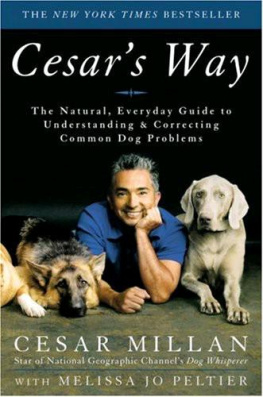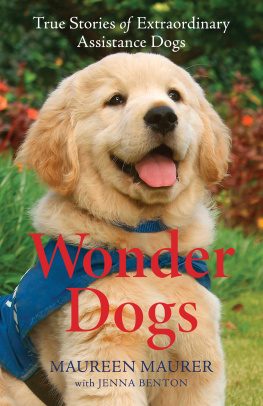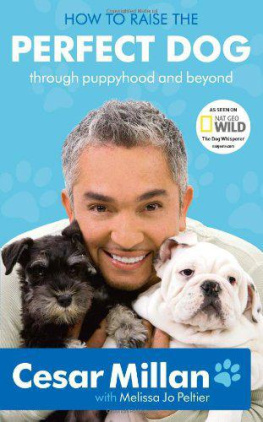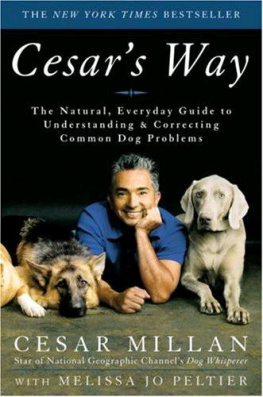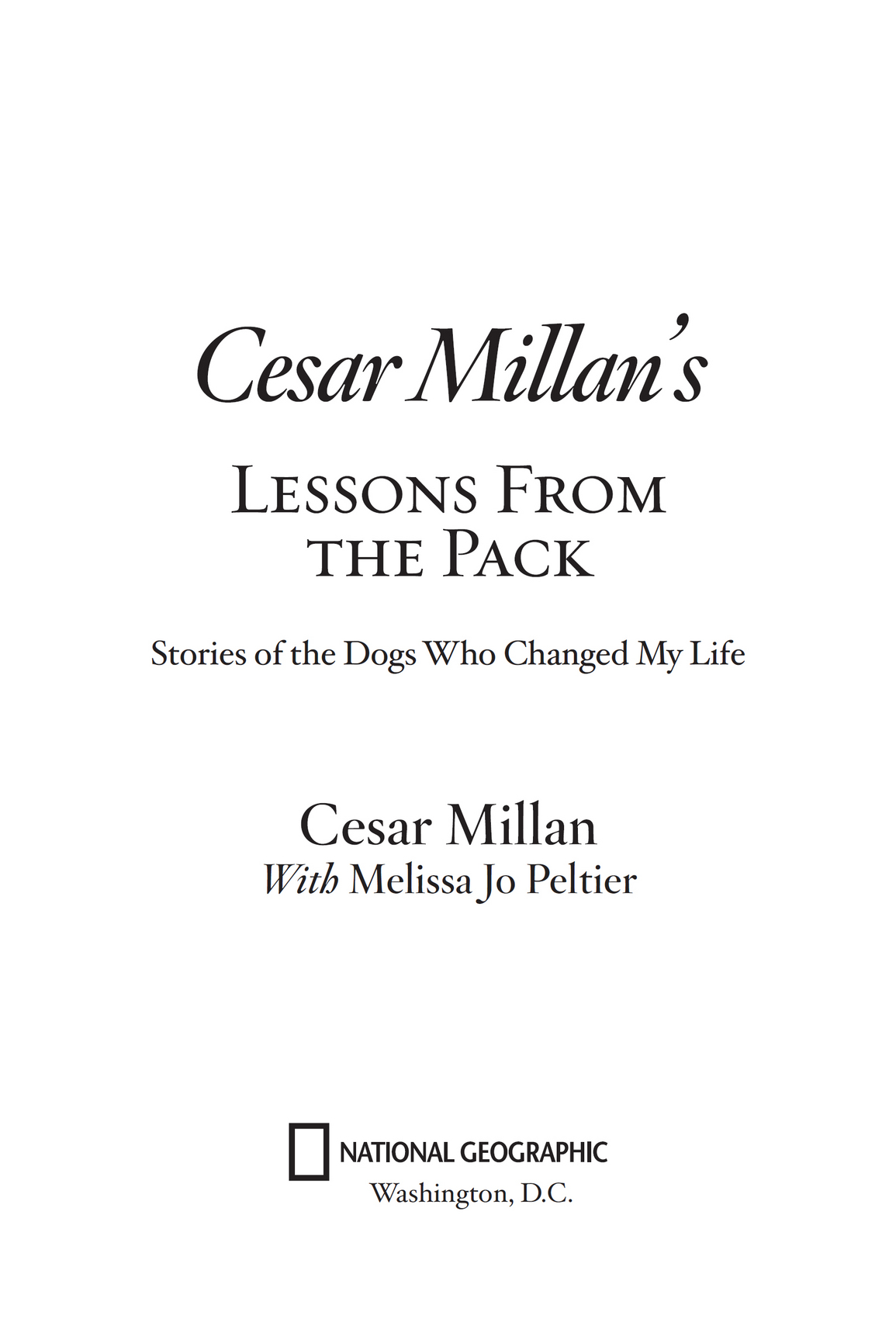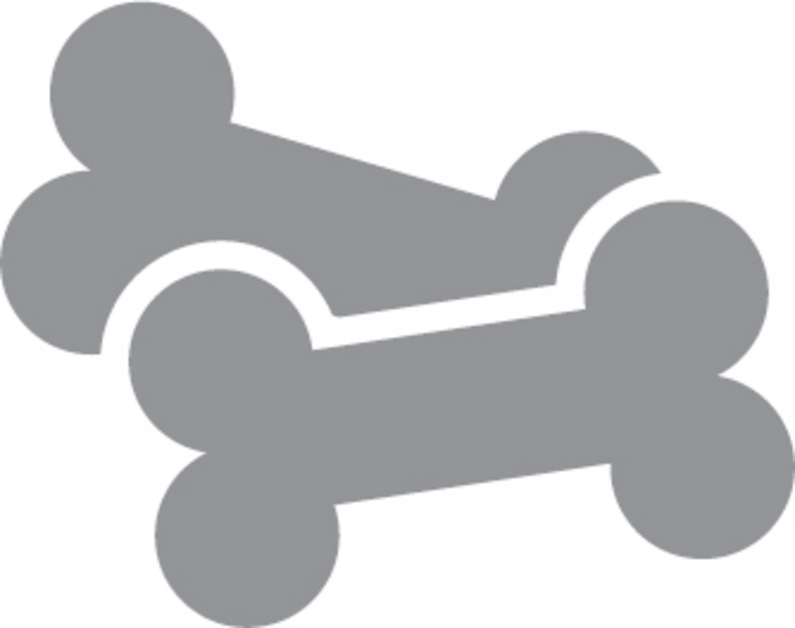Contents
Also by Cesar Millan
Cesar Millans
Short Guide to a Happy Dog
Published by National Geographic Partners
1145 17th Street NW Washington, DC 20036
Copyright 2017 Cesars Way, Inc. All rights reserved. Reproduction of the whole or any part of the contents without written permission from the publisher is prohibited.
NATIONAL GEOGRAPHIC and Yellow Border Design are trademarks of the National Geographic Society, used under license.
Some names and identifying details have been changed in order to protect the privacy of individuals and organizations.
ISBN9781426216138 (hardcover)
ISBN9781426216183 (export edition)
Ebook ISBN9781426216190
Since 1888, the National Geographic Society has funded more than 12,000 research, exploration, and preservation projects around the world. National Geographic Partners distributes a portion of the funds it receives from your purchase to National Geographic Society to support programs including the conservation of animals and their habitats.
National Geographic Partners
1145 17th Street NW
Washington, DC 20036-4688 USA
Become a member of National Geographic and activate your benefits today at natgeo.com/jointoday.
For rights or permissions inquiries, please contact National Geographic Books Subsidiary Rights:
Interior design: Nicole Miller
v4.1
a
To honor the spirit of dogs, in gratitude for everything they have done for me and my family, I dedicate this book to my soulful canine teacher, Daddy. He believed in himself, he believed in me, and he taught me how to help others. Daddy, please keep guiding me to be as wise and good as you were. It was my great privilege to walk beside you, my friend. Everybody misses youespecially me.
God gave unto the Animals
A wisdom past our power to see:
Each knows innately how to live,
Which we must learn laboriously.
Margaret Atwood,
God Gave Unto the Animals
Animals enter our lives prepared to teach and far from being burdened with an inability to speak, they have many different ways to communicate. It is up to us to listen more than hear, to look into more than past.
Nick Trout,
Love Is the Best Medicine
I NTRODUCTION :
M EET Y OUR N EW T EACHERS
Close your eyes with me. Just for a moment. Close your eyes and imagine a day like this:
The morning birds are chattering outside the window as you awaken naturally at dawnyou dont need an alarm clock to tell you when to start your day. The moment the sunlight hits your eyes, you are filled with a mingled sense of excitement, joy, and anticipation. You go seamlessly into your morning yoga routine, stretching and loosening up every muscle in your body before you hurry outside for your morning exercise.
Walking through your neighborhood and reveling in your good health, you take every possible moment to breathe in the fresh air, the scent of the flowers, grass, and trees all around you. Though this is the same walk you take every day, you appreciate it all as if youre experiencing it for the very first time. You see your friends and neighbors, and you linger to greet them enthusiastically, as they, in return, greet you. They, too, are excited about the day that lies ahead.
When you return home for breakfast, your family awaits you. You greet them with even more joy and unbounded love than you did your neighbors. You embrace them, kiss them, and let them know how much you adore and appreciate them before you all rush into the yard and playfully celebrate another day you all get to be together. This is your morning routine every daybecause what is life for, if not to share this incredible sense of wonder and gratitude you feel with the ones you love the most?
When its time to go to work, you arrive with anticipationyou love what you do for a living! It gives you a great sense of pride and self-esteem. You greet each of your colleagues warmly. Even though they are all so very different from you on the outsidedifferent heights and weights, colors, races, religionsyou share the understanding that youre all one species with one common purpose. You respect all the people you work with, from the ones with the most menial jobs to the CEO. And even the CEO shares this accepting attitude. Your companys philosophy is that everyone has a vital role to play in the work you do, and everyone should share fairly in the proceeds.
Every once in a while, you have a disagreement with someone at work. They might have something you want, or perhaps they do something that you dont agree with. But theres no backstabbing in your companyno silent plots, no whispering at the water cooler. No: When you and a colleague dont see eye-to-eye, you speak your mind right away, even if it means a short dust up between the two of you. Itll be over within minutes, the matter will be decided, and youll go on with your day without rancor or resentment.
Sounds like a perfect world, doesnt it? And probably an impossible onemore like an urban fairy tale.
But not necessarily. The scenario I just outlined is a snapshot of what life could be like if humans approached life the way dogs do.
Dogs show us the best we can be.
Over the past 10 years, Ive written six books on the subject of canine behavior, nearly all of them New York Times bestsellers. All contain stories of the many dogs Ive rehabilitated over the years and the techniques Ive used to help them. In those books, I was the teacher. But this book is very different. In this book, the dogs are not the students; they are the teachers. Our teachers. In the pages that follow, I will share for the first time some of the most important lessons that the dogs in my life have taught me.
Our dogs are right in front of us every day, showing us with their every action a better way to live. All too often, we dont pay attention. We take them for granted, thinking we know so much more about life than they do and believing that we have far more to teach them than they could possibly teach us.
In fact, we invest an enormous amount of energy trying to get our dogs to become more like us! We teach them to understand our languageoften without even bothering to learn theirs. We teach them to sit, stay, come, and heel for our convenience, not theirs. We pamper them like children (when they really dont care about who has the prettiest toys), and we dress them in couture outfits (when they couldnt give a hoot about fashion).
None of that makes sense to me. Here we are teaching our dogs to behave as we do even while many of us struggle to find happy relationships with members of our own species. Dogs are designed by nature to value qualities like honor, respect, ritual, compassion, honesty, trust, loyalty, and compassion. They instinctually understand the importance of pack hierarchy and mutually beneficial relationships. So instead of teaching them what we think they should learn from us, what if we took the opportunity to learn from them?


